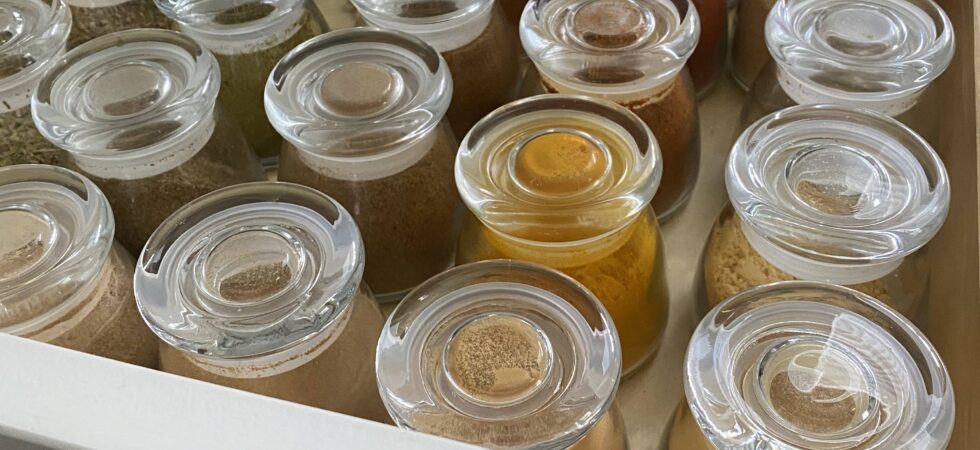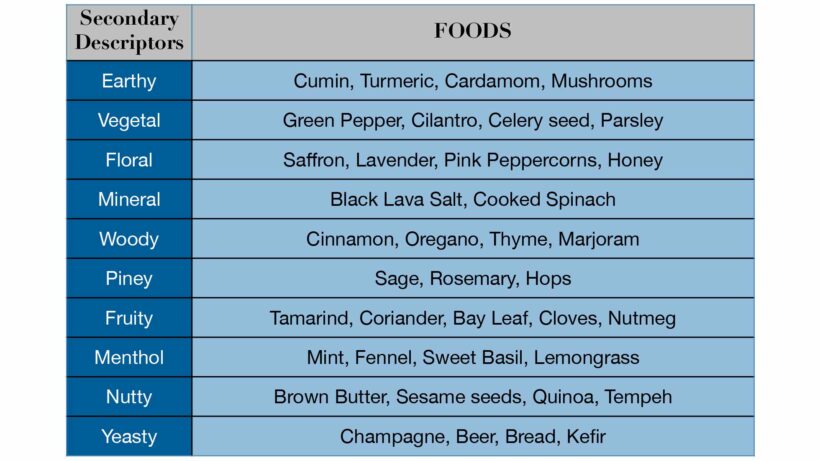The 4 Elements of Flavor

First things first, this post is not something that will immediately make you a master chef after reading it. I’m writing this post to help draw attention to the fact that there is just sooooo much more to food than, “this tastes good” or, “this tastes bad.”
It is my hope, that this post makes you aware of the ways in which you can consider, critique, and change a dish to match YOUR tastes.
You know when someone points out a mistake in a movie or an odd sound in a song and you just can’t un-see or un-hear it? Yeah, I’m going to do that to you. Sorry, not sorry.
So, without further ado, here is a breakdown of the 4 elements of flavor.
Taste
The first and most considered element of flavor is TASTE
Quoting from the book, The Cork Dork, by Bianca Bosker, “We obsess over finding or making food and drink that tastes better—planning travel itineraries, splurging on tasting menus, buying exotic ingredients, lusting after the freshest produce. Yet, we do nothing to teach ourselves to be better tasters. “We are as a nation taste-blind,”wrote M.F.K. Fisher, a criticism that, from everything I’d observed, remains as true today as it was in 1937.”
Although taste only makes up roughly 20% of flavor. It’s the knockout punch needed to fully experience an ingredient or dish. Don’t worry, there is an easy way to become a better taster. Drumroll please…
Taste everything and anything you can! Taste individual ingredients. Taste them in different combinations. Taste a whole dish. Be a little bit scientific about it. And, please for the love of GOD. Slow down! Be present when you eat or cook. Really, mull over what something tastes like. Revolutionary advice I know. But, it’s still true. The fastest way to get better at anything is practice and CliffsNotes. So you practice and here are some helpful charts for the CliffsNotes part.

The above chart has some common foods sorted into their main flavor category. Read and think about what each one tastes like, then contemplate if any food listed has other flavor components. Some ingredients can have multiple tastes depending on which part you use.
Let’s do a quick thought experiment:
- Lemon juice, though prominently sour/acidic, also has a sweetness to it. And, a lemon’s pith is bitter. Taking this thought a step further, think about a grapefruit. It also has sour and sweet components, but grapefruits have a bitterness not present in lemons. Everyone with me?
- Another great example is chocolate. Depending on the ratio of sugar, cocoa, and cocoa butter, it can be as sweet as milk chocolate and as bitter as unsweetened dark chocolate.
The next time you are out at a restaurant or even in your kitchen, scrutinize your food and try to pick out these main tastes as best you can. Who cares if someone catches you licking the plate! Be weird and have fun! Because, it’s the individual parts and nuances we must take notice of to understand how individual ingredients come together and layer flavor in a dish.
Now, in my opinion, the most important tastes to practice are the first group. And, I know you thought I’d just leave you there, but there are actually secondary tastes to think about as well. I’d say to wait on working through the second chart until you feel like you have mastered the first chart of tastes. Also, this is not the most extensive list, but there are a fair amount of secondary tastes to review.

This chart makes me think about a recent episode of the Taste podcast. Interviewee (Helen Rosner) rightly and hilariously said, there is just no way to talk about wine without sounding like a complete douche. I may have laughed out loud and frightened a few people near me, but what she said is inescapably true. These secondary tastes are used A LOT when describing wine. In fact, you’ve probably heard someone drone on about earthiness in a glass of Cab Franc or the minerality in a glass of Sauvignon Blanc. I have news for you, chefs and cooks talk about food the same way.
I’m about to blow your mind. Ready? Not only can you taste these secondary descriptors, you can also smell them. Which leads me to the next element of flavor, aroma.
Aroma
80% of flavor comes from aromatic compounds and what our olfactory senses are picking up before we take the first bite.
Makes you think about the second chart in a new light doesn’t it? Good.
The next time you eat something, try not to smell it before you take a bite. Not working? Didn’t think so. Our sense of smell is our natural first line of information, whether it’s pleasant or unpleasant. For instance, you might instinctively back away when you smell sour garbage or gasoline and move towards the freshly cooked meal on the counter.
Here’s another experiment to help you master the secondary chart. If you have a second person with you this will be easier. Randomize some spices on your counter and close your eyes. Now give each container a sniff and see if you can guess what’s in it. Are you smelling any of the described attributes in the second list? Can you organize any of them into groups? Which ones went where?
How else can you modify the way we perceive the foods we taste and smell? Easy, change the temperature.
Temperature
Our third element, temperature, does two things. Chilling food mutes both taste and aroma, while heat inversely increases some of them. That’s why your wine or beer goes from crisp to cloying as they warm. It’s also why some dishes are traditionally served at specific temperatures.
Here’s the quick and dirty science. As temperature increases, we perceive the sweetness and bitterness in foods more intensely, with sweetness winning out the warmer the food gets. Additionally, smells will be stronger at higher temperatures. As our food heats up the molecules move around faster and faster creating more intense aromas.
Understanding how flavors can intensify at difference temperatures, will help you decide how much seasoning you need in a cold versus hot dish.
Another experiment you say? I got you covered! eat some grapes (or other fruit) three ways: at room temperature; refrigerated; and frozen. See if you can discern the differences in flavor and smell for each.
Notice something other than a difference in flavor? Maybe also a difference in texture?
Texture
Texture, the final element to a dish’s flavor, is all about how food feels in your mouth. Examples would be the crunchiness of granola, the silkiness of tofu, the dryness of tannins from your morning cup of black tea (just me? Okay fine morning cup of coffee) and, the viscosity in honey.
The thickness of an ingredient also determines how quickly a food heats up and can be recognized by our taste buds. Double Whammy!
Thought experiment time! Question: At what point do you start to taste sweetness when you eat dark chocolate? Is it immediately sweet? No, it actually starts slightly bitter before it melts. The change in texture from hard and a bit waxy to smooth and creamy allows the taste of the chocolate to coat your tongue, which in turn increases it temperature and the intensity of the sweetness over the bitterness.
From now on, I encourage you to notice how quickly a food coats your tongue and how long it lingers before it’s gone.
On that note, I think we have covered the 4 elements of flavor just enough to make all of you dangerous. Time to wrap things up! I hope reading this post makes discussions about mouthfeel or aroma not quite as snobbish at the very least and unlocked a whole world of flavor for you at the very best. If you can learn these concepts and connect to them, you too can start breaking down the individual ingredients and the overall dish in a way that leads to your own successful mad scientist moments.
Let this be a jumping-off point to mastering the seasoning and flavoring in dishes as well as understanding how a recipe will blend and build as you read a blogger’s list of ingredients. Build up a codex in your brain as best you can, taste as much as you can, and practice, practice, practice!
Speaking of blending and building ingredients… we covered a lot of individual ingredients and elements in this post. Next time I’ll walk you through balancing and enhancing multiple ingredients to affect the overall flavor of a dish.

This is all seriously so helpful thank you thank you thank you
I am so glad you enjoyed the post! 😀